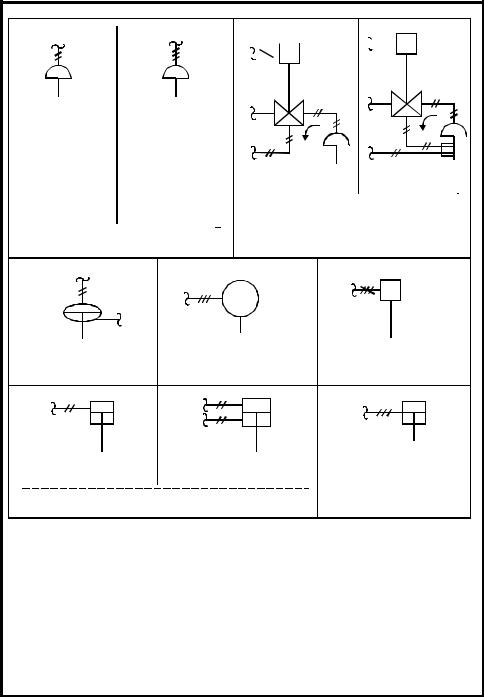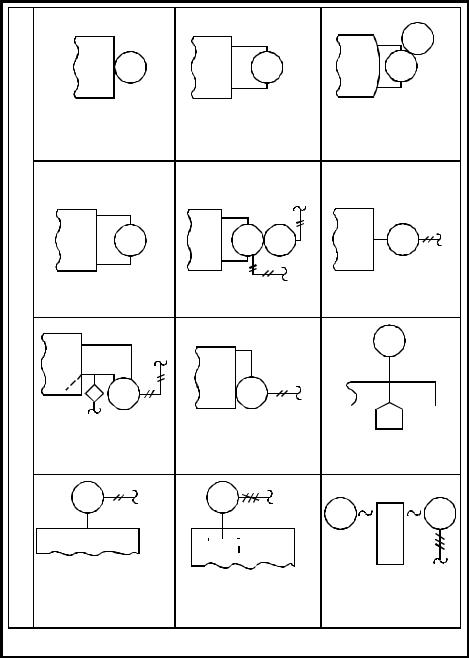
Measurement and Control Basics 3rd Edition (complete book)
.pdf


348 Measurement and Control Basics
defined outside a tagging bubble on a flow diagram. For example, XR-2 may be a stress recorder and XX-4 may be a stress oscilloscope.
3.The grammatical form of the succeeding-letter meanings may be modified as required. For example, "indicate" may be applied as "indicator" or "indicating," "transmit" as "transmitter" or "transmitting," etc.
4.Any first-letter, if used in combination with modifying letters
D (differential), F (ratio), M (momentary), K (time rate of change), Q (integrate or totalize), or any combination of these is intended to represent a new and separate measured variable, and the combination is treated as a first-letter entity. Thus, instruments TDI and TI indicate two different variables, namely, differentialtemperature and temperature. Modifying letters are used when applicable.
5.First-letter A (analysis) covers all analyses not described by a "user's choice" letter. It is expected that the type of analysis will be defined outside a tagging bubble.
6.Use of first-letter U for "multivariable" in lieu of a combination of first-letters is optional. It is recommended that nonspecific variable designators such as U be used sparingly.
7.The use of modifying terms "high," "low," "middle" or "intermediate," and "scan" is optional.
8.The term "safety" applies to emergency protective primary elements and emergency protective final control elements only. Thus, a self-actuated valve that prevents operation of a fluid system at a higher-than-desired pressure by bleeding fluid from the system is a back-pressure-type PCV, even if the valve is not intended to be used normally. However, this valve is designated as a PSV if it is intended to protect against emergency conditions, i.e., conditions that are hazardous to personnel and/or equipment and that are not expected to arise normally.
The designation PSV applies to all valves intended to protect against emergency pressure conditions regardless of whether the valve construction and mode of operation place them in the category of the safety valve, relief valve, or safety relief valve. A rupture disc is designated PSE.
9.The passive function G applies to instruments or devices that provide an uncalibrated view, such as sight glasses and television monitors.
350Measurement and Control Basics
14.It is expected that the functions associated with the use of succeeding-letter Y will be defined outside a bubble on a diagram when further definition is considered necessary. This definition need not be made when the function is self-evident, as for a solenoid valve in a fluid signal line.
15.The modifying terms "high," and "low," and "middle" or "intermediate" correspond to values of the measured variable, not to values of the signal, unless otherwise noted. For example, a high-level alarm derived from a reverse-acting level transmitter signal should be an LAH, even though the alarm is actuated when the signal falls to a low value. The terms may be used in combinations as appropriate. (See Section 6.9A.)
16.The terms "high" and "low," when applied to positions of valves and other open-close devices, are defined as follows: "high" denotes that the valve is in or approaching the fully open position, and "low" denotes that it is in or approaching the fully closed position.
17.The word "record" applies to any form of permanent storage of information that permits retrieval by any means.
18.For use of the term "transmitter" versus "converter," see the definitions in Section 3.
19.First-letter V, "vibration or mechanical analysis," is intended to perform the duties in machinery monitoring that the letter A performs in more general analyses. Except for vibration, it is expected that the variable of interest will be defined outside the tagging bubble.
20.First-letter Y is intended for use when control or monitoring responses are event-driven as opposed to timeor time scheduledriven. The letter Y, in this position, can also signify presence or state.
21.Modifying-letter K, in combination with a first-letter such as L, T, or W, signifies a time rate of change of the measured or initiating variable. The variable WKIC, for instance, may represent a rate-of- weight-loss controller.
22.Succeeding-letter K is a user's option for designating a control station, while the succeeding-letter C is used for describing automatic or manual controllers. (See Section 3, Definitions.)

|
|
Appendix A – Standard Graphics Symbols for Process Control and Instrumentation |
351 |
||||||
Table A-3. Instrument Identification Letters (1) |
|
|
|
|
|||||
|
|
|
|
|
|
|
|
|
|
|
|
FIRST-LETTER (4) |
|
SUCCEEDING-LETTERS (3) |
|
|
|||
|
|
|
|
|
|
|
|
|
|
|
|
MEASURED OR |
|
|
READOUT OR |
|
|
|
|
|
|
INITIATING |
|
|
PASSIVE |
OUTPUT |
|
|
|
|
|
VARIABLE |
MODIFIER |
|
FUNCTION |
FUNCTION |
MODIFIER |
|
|
|
|
|
|
|
|
|
|
|
|
|
A |
Analysis (5,19) |
|
|
Alarm |
|
|
|
|
|
|
|
|
|
|
|
|
|
|
|
B |
Burner, Combustion |
|
|
User's Choice (1) |
User's Choice (1) |
User's Choice( |
1) |
|
|
|
|
|
|
|
|
|
|
|
|
C |
User's Choice (1) |
|
|
|
Control (13) |
|
|
|
|
|
|
|
|
|
|
|
|
|
|
D |
User's Choice (1) |
Differential (4) |
|
|
|
|
|
|
|
|
|
|
|
|
|
|
|
|
|
E |
Voltage |
|
|
Sensor (Primary |
|
|
|
|
|
|
|
|
|
Element) |
|
|
|
|
|
|
|
|
|
|
|
|
|
|
|
F |
Flow Rate |
Ratio (Fraction) (4) |
|
|
|
|
|
|
|
|
|
|
|
|
|
|
|
|
|
G |
User's Choice (1) |
|
|
Glass, Viewing |
|
|
|
|
|
|
|
|
|
Device (9) |
|
|
|
|
|
|
|
|
|
|
|
|
|
|
|
H |
Hand |
|
|
|
|
High (7, 15, 16) |
|
|
|
|
|
|
|
|
|
|
|
|
|
I |
Current (Electrical) |
|
|
Indicate (10) |
|
|
|
|
|
|
|
|
|
|
|
|
|
|
|
J |
Power |
Scan (7) |
|
|
|
|
|
|
|
|
|
|
|
|
|
|
|
|
|
K |
Time, Time Schedule |
Time Rate of |
|
|
Control Station |
|
|
|
|
|
|
Change 4, 21) |
|
|
(22) |
|
|
|
|
|
|
|
|
|
|
|
|
|
|
L |
Level |
|
|
Light (11) |
|
Low (7, 15, 16) |
|
|
|
|
|
|
|
|
|
|
|
|
|
M |
User's Choice (1) |
Momentary(4) |
|
|
|
Middle, |
|
|
|
|
|
|
|
|
|
Intermediate(7,15) |
|
|
|
|
|
|
|
|
|
|
|
|
|
N |
User's Choice (1) |
|
|
User's Choice (1) |
User's Choice (1) User's Choice |
(1) |
||
|
|
|
|
|
|
|
|
|
|
|
O |
User's Choice( 1) |
|
|
Orifice, Restriction |
|
|
|
|
|
|
|
|
|
|
|
|
|
|
|
P |
Pressure, Vacuum |
|
|
Point (Test) |
|
|
|
|
|
|
|
|
|
Connection |
|
|
|
|
|
|
|
|
|
|
|
|
|
|
|
Q |
Quantity |
Integrate, |
|
|
|
|
|
|
|
|
|
Totalize(4) |
|
|
|
|
|
|
|
|
|
|
|
|
|
|
|
|
|
R |
Radiation |
|
|
Record (17) |
|
|
|
|
|
|
|
|
|
|
|
|
|
|
|
S |
Speed, Frequency |
Safety (8) |
|
|
Switch (13) |
|
|
|
|
|
|
|
|
|
|
|
|
|
|
T |
Temperature |
|
|
|
Transmit (18) |
|
|
|
|
|
|
|
|
|
|
|
|
|
|
U |
Multivariable(6) |
|
|
Multifunction(12) |
Multifunction (12) |
Multifunction (12) |
|
|
|
|
|
|
|
|
|
|
|
|
|
V |
Vibration, Mechanical |
|
|
|
Valve, Damper, |
|
|
|
|
|
Analysis(19) |
|
|
|
Louver (13) |
|
|
|
|
|
|
|
|
|
|
|
|
|
|
W |
Weight, Force |
|
|
Well |
|
|
|
|
|
|
|
|
|
|
|
|
|
|
|
X |
Unclassified (2) |
X Axis |
|
Unclassified (2) |
Unclassified (2) |
Unclassified (2) |
|
|
|
|
|
|
|
|
|
|
|
|
|
Y |
Event, State or |
Y Axis |
|
|
Relay, Compute, |
|
|
|
|
|
Presence (20) |
|
|
|
Convert (13, 14, |
|
|
|
|
|
|
|
|
|
18) |
|
|
|
|
|
|
|
|
|
|
|
|
|
|
Z |
Position, Dimension |
Z Axis |
|
|
Driver, Actuator, |
|
|
|
|
|
|
|
|
|
Unclassified Final |
|
|
|
|
|
|
|
|
|
Control Element |
|
|
|
|
|
|
|
|
|
|
|
|
|
NOTE: Numbers in parentheses refer to specific explanatory notes in Section 5.1.
352 Measurement and Control Basics
BIBLIOGRAPHY
1.ANSI/ISA-5.1-1984, Instrument Symbols and Indentification, ISA, Research Triangle Park, NC, 1984.

354 |
Measurement and Control Basics |
|
|
|
|
|
|
|
|||
|
Table B-2. Type T: Copper-Constantan |
|
|
|
|
|
|||||
|
|
|
|
|
|
|
|
|
|
|
|
|
°C |
0 |
5 |
10 |
15 |
20 |
25 |
30 |
35 |
40 |
45 |
|
|
|
|
|
|
|
|
|
|
|
|
|
–150 |
–4.60 |
–4.71 |
–4.82 |
–4.92 |
–5.02 |
–5.11 |
–5.21 |
–5.29 |
–5.38 |
|
|
–100 |
–3.35 |
–3.49 |
–3.62 |
–3.76 |
–3.89 |
–4.01 |
–4.14 |
–4.26 |
–4.38 |
–4.49 |
|
–50 |
–1.80 |
–1.97 |
–2.14 |
–2.30 |
–2.46 |
–2.61 |
–2.76 |
–2.91 |
–3.06 |
–3.21 |
|
–0 |
0.00 |
–0.19 |
–0.38 |
–0.57 |
–0.75 |
–0.93 |
–1.11 |
–1.29 |
–1.46 |
–1.64 |
|
+0 |
0.000 |
0.193 |
0.389 |
0.587 |
0.787 |
0.990 |
1.194 |
1.401 |
1.610 |
1.821 |
|
50 |
2.035 |
2.250 |
2.467 |
2.687 |
2.908 |
3.132 |
3.357 |
3.584 |
3.813 |
4.044 |
|
100 |
4.277 |
4.512 |
4.749 |
4.987 |
5.227 |
5.469 |
5.712 |
5.957 |
6.204 |
6.453 |
|
150 |
6.703 |
6.954 |
7.208 |
7.462 |
7.719 |
7.987 |
8.236 |
8.497 |
8.759 |
9.023 |
|
200 |
9.288 |
9.555 |
9.823 |
10.09 |
10.36 |
10.64 |
10.91 |
11.18 |
11.46 |
11.74 |
|
250 |
12.02 |
12.29 |
12.58 |
12.86 |
13.14 |
13.43 |
13.71 |
14.00 |
14.29 |
14.57 |
|
300 |
14.86 |
15.16 |
15.45 |
15.74 |
16.04 |
16.33 |
16.63 |
16.93 |
17.22 |
17.52 |
|
395 |
17.82 |
18.12 |
18.43 |
18.73 |
19.03 |
19.34 |
19.64 |
19.95 |
20.26 |
20.57 |
|
|
|
|
|
|
|
|
|
|
|
|



 S
S 
 S
S